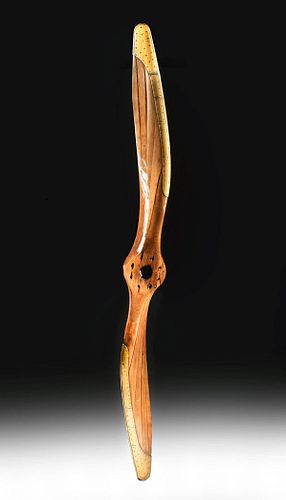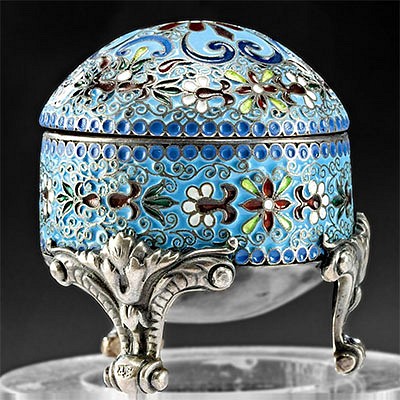Early 20th C. American Wood Biplane Propeller
Lot 103a
About Seller
Artemis Gallery
686 S Taylor Ave, Ste 106
Louisville, CO 80027
United States
Selling antiquities, ancient and ethnographic art online since 1993, Artemis Gallery specializes in Classical Antiquities (Egyptian, Greek, Roman, Near Eastern), Asian, Pre-Columbian, African / Tribal / Oceanographic art. Our extensive inventory includes pottery, stone, metal, wood, glass and textil...Read more
Categories
Estimate:
$8,000 - $12,000
Absentee vs Live bid
Two ways to bid:
- Leave a max absentee bid and the platform will bid on your behalf up to your maximum bid during the live auction.
- Bid live during the auction and your bids will be submitted real-time to the auctioneer.
Bid Increments
| Price | Bid Increment |
|---|---|
| $0 | $25 |
| $300 | $50 |
| $1,000 | $100 |
| $2,000 | $250 |
| $5,000 | $500 |
| $10,000 | $1,000 |
| $20,000 | $2,500 |
| $50,000 | $5,000 |
| $100,000 | $10,000 |
| $200,000 | $20,000 |
About Auction
By Artemis Gallery
Apr 1, 2021
Set Reminder
2021-04-01 12:00:00
2021-04-01 12:00:00
America/New_York
Bidsquare
Bidsquare : Odd Unusual Finds | Antiquity to Present Day
https://www.bidsquare.com/auctions/artemis-gallery/odd-unusual-finds-antiquity-to-present-day-6742
Ancient, Asian, Pre-Columbian, Ethnographic, American, and everything in-between Wild, weird, strange, interesting - who knows what you'll find. All pieces guaranteed to be as described. Convenient in-house shipping. Artemis Gallery info@artemisgallery.com
Ancient, Asian, Pre-Columbian, Ethnographic, American, and everything in-between Wild, weird, strange, interesting - who knows what you'll find. All pieces guaranteed to be as described. Convenient in-house shipping. Artemis Gallery info@artemisgallery.com
- Lot Description
North America, USA, from Clover Field Airport, Santa Monica, California (the first airport in that city), ca. 1917 to 1922 CE. An absolutely gorgeous piece of early aviation history, this is a massive wood and brass propeller from a biplane. Airplane aesthetics have captivated us since the earliest days of mechanical flight, and this piece is a fabulous example of why - its graceful curves, symmetrical form, brass rivets, and polished brass edges instantly call to mind the romance of early travel. The shape is scimitar like, with each tip having a long brass sheath held in place with dozens of rivets. Stamped near the hub are some numbers and letters that appear to read, "2253 DN 152 8' 8"" with the final two denoting the width of the propeller and the first four the serial number. In accordance with early propellers, it is over eight feet long - indicating the slower RPM, in the 1200 to 1700 range, of early planes (later propellers would be 6-8 feet long for higher RPM engines). The hub has 8 bolt holes. Size: 105.25" W x 8.75" H (267.3 cm x 22.2 cm)
Clover Field Airport is notable for being the initial takeoff and final landing point for the first air circumnavigation of the Earth in 1924. It took a fleet of four planes from March 17 to September 23 - with only two planes reaching the end - to complete the feat. With the serial number somewhat difficult to read, it is hard to identify this propeller. It may have been made by Gardner Propellers of Illinois.
Provenance: private Hawaii, USA collection; ex Santa Monica, California, USA collection
All items legal to buy/sell under U.S. Statute covering cultural patrimony Code 2600, CHAPTER 14, and are guaranteed to be as described or your money back.
A Certificate of Authenticity will accompany all winning bids.
We ship worldwide and handle all shipping in-house for your convenience.
#148500Professionally restored by a conservator. Highly polished with a loss to one side of the hub that could not be restored. The serial number is difficult to read and may have been partially obscured by the restoration.Condition
- Shipping Info
-
All shipping is handled in-house for your convenience. Your invoice from Artemis Gallery will include shipping calculation instructions. If in doubt, please inquire BEFORE bidding for estimated shipping costs for individual items.
-
- Buyer's Premium



 EUR
EUR CAD
CAD AUD
AUD GBP
GBP MXN
MXN HKD
HKD CNY
CNY MYR
MYR SEK
SEK SGD
SGD CHF
CHF THB
THB


















